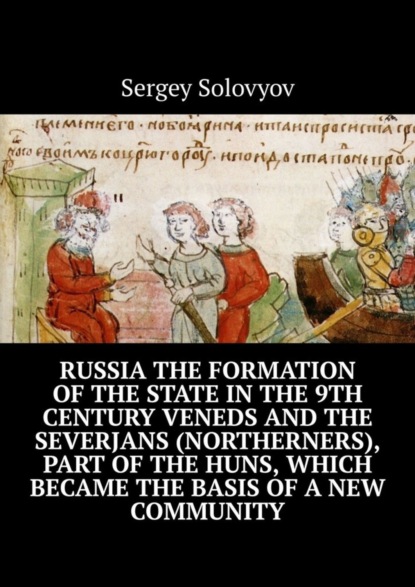
Полная версия:
Russia the formation of the state in the 9th century Veneds and the severjans (northerners), part of the Huns, which became the basis of a new community
In the spielman’s poem “Ortnit”, created at the beginning of the 13th century in southeastern Germany, the plot is localized in the Lombard kingdom, that is, separate legends that have existed since at least the 4th-6th centuries are used.) Ilya Muromets appears in this poem as a Russian king and as a noble relative of the powerful Lombard king Ortnit. It is Ilya who advises the young king to go in search of future queens to the Middle East, to the land of the Saracens, and then accompanies Orthnita in this dangerous enterprise.
Dô sprach von den Riuzen der künic Vljas,
wan er dâ nach Ortnîden der tiweriste was.
ich weiz eine frouwen schoene und wol geborn,
der gebat nie man, er hiete daz houbet sîn verlorn.
In the Russian epic, Volkh-Veles appears as a deity born of the Dragon, here is the younger son, like Ivan Tsarevich. The form of the name Vljas, is identical to Veles or Volkh, and Ilya the Russian is identical to Veles-Volkh – he also goes on a march to the south (Hike to Syria, not India, as in the epic), where he gets a wife, though not to himself, as in the epic “Volkh Vseslavovich”, and brother Ortnit. (Probably, it is probably that the name Arthur can be traced here). This myth is similar to the legend about three brothers dividing the world – one to the left, the other to the right, and the younger one knows where, in this case, to Greece. The Spielman epic is a unique phenomenon in its own way. German spielmans of the 11th – 13th centuries represented the most democratic and mobile layer in the written literature of that time.
Written evidence
Homer can be called the oldest writer. Earlier than all, the Wends are mentioned by Homer, called the Aeneians or the Aenians, and their ruler, the king of the city of Cephas in Thessaly, is called Hunei, and here we see the Huns-Huns of antiquity.
But from Kifa Guney with twenty and two ships
He sailed, leading the Aenians and the warlike, strong Perrebians,
A tribe of men who settled around Dodona cold,
The lands of those who plowed, on whom the merry Titaresus makes noise,
Quickly in Penei rushing magnificently rolling waters,
Which he does not merge anywhere with the Penei of silver,
Homer. Iliad II 748
That is, Homer indicates where the Huns-Gants lived in a time close to him – in Thessaly, where it was possible to engage in horse breeding, and the Eneta-Venets are immediately mentioned, and next to the Huns, which will be important in the future.
And they, as part of the Huns-Hans, came to Asia Minor and Hellas at the beginning of the II millennium BC. The earliest news of the Roman writers about the Wends date back to the end of the 1st-2nd centuries. n. e. and belong to Roman writers – Pliny the Elder, Publius Cornelius Tacitus and Ptolemy Claudius, and Arrian, although apparently Herodotus mentioned the Wends in the 5th century. BC BC, when he wrote that amber was brought from the Eridani River from the Enets (Venets), Quintus Curtius Rufus also wrote about them in his book about the campaign of Alexander the Great, and says that they lived in Asia Minor. According to Pliny (I century, the Wends lived on the southeastern coast of the Baltic Sea east of Vistula. Pliny the Elder and Pomponius Mela tell the story of the proconsul of Gaul Quintus Metellus Celer about how a storm nailed a ship with merchants of the Wind people (Venets) to the northern coast of Germany. For half a century, Tacitus places the Wends in the area between the Vistula River (Vistula) and the Aestia (Zsty). Tacitus hesitated in his judgment: whether to classify them as Germans or Sarmatians. Based on the fact that they “put houses”, “use shields” and “willingly move on foot”, he nevertheless considered them different from the Sarmatians,’ who live in a cart and on horseback. ‘On the Peitinger map, edited from the 1st century AD to the 5th century AD, the Wends are localized in two places, the first time (as Venadi) from the north of the Carpathians, the second (as Venedi) in the lower reaches of the Danube (in the region of the Ipotesti-Kindesh culture).
The Gothic historian Jordan, in his story “On the origin and deeds of the Getae (Getik)” (551), described the places of residence of the Veneti
“… At their left slope [the Carpathians], descending to the north, starting from the birthplace of the Vistula River, a populous tribe of Venets is located in immense spaces. Although their names now change according to different clans and localities, they are still predominantly called Sklavens and Antes. Sklavens live from the city of Novietaunai Lake, called Mursian Lake, to Dunastr [Dniester], and to the north – to Viskla [Vistula], instead of cities they have swamps and forests. The Antes, the strongest of both [tribes], spread from Danastr to Danapr [Dnieper], where the Pontic [Black] Sea forms a bend; these rivers are removed from one another at a distance of many crossings”
In the same place, at Jordan, it is mentioned that during the time of the Ostrogoth [Ostrogothic] king Germanarich (died in 375 or 376 AD), the Wends tribe was subject to him along with other Proto-Slavic tribes:
“These [Venets], as we have already told at the beginning of our exposition, – precisely when listing the tribes, – come from one root and are now known under three names: Venets, Antes, Sklavens. Although now, due to our sins, they rage everywhere, but then they all submitted to the authority of Germanarich.”
The Byzantine writer Procopius of Caesarea wrote about the Ants and Slavs in his “War with the Goths”:
“And once even the name of the Slavs and the Antes was the same. In ancient times, both of these tribes were called disputes (‘scattered’), I think, because they lived, occupying the country ‘sporaden, scattered’, in separate villages. That is why they need to occupy a lot of land. These tribes, the Slavs and the Antes, were not ruled by one person, but since ancient times they have lived in the rule of the people (democracy) and therefore happiness and unhappiness in life is considered a common thing for them”
That is, they lived in separate cities, far from each other, according to Procopius. But-the name SPORA-has another meaning in Hellenic, in the sense of seeds and sown.
Helmold, who in his “Slavic Chronicle” writes:
“Where Polonius ends, we come to the vast country of those Slavs, who in ancient times were called Vandals, but now they are Vinites, or Vinules.”
In addition to Jordan, Latin writers of the 7th-8th centuries also identified the Wends with the Slavs: in the chronicle of Fredegar (7th century), the Wends (Winedos) are mentioned more than once in connection with the Slavs (Sclavos) in connection with the events of 623:
“Slavs, called Wends”, “Slavs, who are known as Wends.”
Jonah (eng.). from Bobbio, who lived in the 7th century, in his Life of Saint Columban wrote:
“Meanwhile, the idea came to my mind to go to the borders of the Venetians (Venetiorum), who are also called the Slavs (Sclavi) …”. Anglo-Saxon writer Alcuin, who lived during the time of Charlemagne, wrote in his letter (dated 790): “But in the past year, the king with an army rushed to the Slavs (Sclavos), whom we call the Vionudos…”.
The Oslavs were written by Patriarch Photius, Leo the Deacon described in detail the Russian-Byzantine wars.
Sigismund Herberstein argued that the word Russei comes from the translation from the Greek “sporaden”: Although rather from Rasti, Rosly.
“Your country is called Raseya because your ancestors lived absentmindedly, that is,” sporadic”
Russia, the Slavs are also mentioned in Arab sources. The “Note” by Ahmed Ibn-Fadlan is an extremely important source on the history of Eastern Europe in the 10th century. Its author visited the Volga Bulgaria as part of the embassy of the Abbasid Caliph al-Muktadir (908—932). Abu Ali Ahmed Ben-Omar Ibn-Dasta, “Al-Masoudi. Ibn Hawkal, Al-Akhtala, Al-Jarmi, Ibn Khordabeh,
Persian historian of the XIII century Fakhr ad-din Mubarak-shah Marvarrudi, Arab writer Ibn-al-Nadim in the “Book of the list of news about scientists and the names of books written by them.
Orbini mentions several times Geremia Russo, who wrote the Russian chronicles in 1227 (Orbini also calls them Muscovite chronicles). According to information from Mavro Orbini, Eremey Russian was the author of the Russian annals (Italian Annali di Russia; 1227) (sometimes as Annali di Moscovia). The composition has not reached the present time. In Orbini’s work, some passages from there are cited. His remarks about the Marcomanians, with the above inscription, show that the Marcomanians were a Slavic tribe. Eremey the Russian discovered an inscription in the mountains of Bohemia when he accompanied the ambassador of Russia (Probably the Volyn principality) to Vienna.
“This stone was placed as a sign of peace between the Crooks, us, the Marcomanians, and the Slavic brothers, the summer of our war… Let the Marcoman pass, not the Slav… the stone.. peace forever and ever.”
Mavro Orbini repeatedly mentions Eremey the Russian. Orbini mentions several times Geremia Russo, who wrote the Russian chronicles in 1227 (Orbini also calls them Muscovite chronicles). According to information from Mavro Orbini, Eremey Russian was the author of the Russian annals (Italian Annali di Russia; 1227) (sometimes as Annali di Moscovia). The composition has not reached the present time. In Orbini’s work, some passages from there are cited. His remarks about the Marcomanians, with the above inscription, show that the Marcomanians were a Slavic tribe. Eremey the Russian discovered an inscription in the mountains of Bohemia when he accompanied the ambassador of Russia (Probably the Volyn principality) to Vienna.
“This stone was placed as a sign of peace between the crooks, us, the Marcomanians, and the Slavic brothers, the summer of our war… Let the Marcoman pass, not the Slav… the stone.. peace forever and ever.”
Most likely, Eremey Russky comes from Galicia-Volyn Rus, in general, the political activity of the Volyn princes in Austria was associated with the kinship of Danila Galitsky and Friedrich Babenberg, their mothers were cousins, that is, in this vein, the embassy of Eremey the Russian to Vienna, to the court of the duke Austria is quite justified. Who can this be? Most likely, one of the close boyars Daniil Romanovich. The name Eremey (Jeremiah) was often used in Western Russia, and the most famous is the famous Jeremiah Vishnevetsky. Eremey Russian is an elderly Russian historian about whom reliable information remains.
And not only Finnish, but also Swedish. The historian Olaf Dalin writes about this in his history of Sweden, he wrote: “Hunagard (the country of the Huns). Previously, this country was called Vanaland or Vanland after the Van, that is, the Wends. “And then he clarified: “… the Vans are the ancestors of the Huns… Vanland is one with Hunagard.” [Olaf Dalin, 110] Another Swedish historian, Olaf Vereli, expressed himself no less definitely on this matter: “By the name of the Huns, our ancestors (Swedes) understood Slavs, later called Windows or Veneti.”
Slavic apocrypha, songs, legends
The study of the origin of the people is completely impossible without studying its customs, myths and songs.
History “Legends about Slovenia and Ruse”. “The Legend of Slovenia and Ruse and the City of Slovensk”, also known as the story “About the history of the hedgehog about the beginning of Rusky lands and the creation of Novagrad”, exists in more than 100 copies of the 17th and 18th centuries; the oldest dates back to 1630. Most of them belong to the second half of the 17th century, including the lists in the Chronicle of Patriarch Nikon, the Chronograph of 1679, and the Novgorod III Chronicle. Modern editions are usually based on a list from the Chronograph of 1679. Historians suggest that the Legend… was compiled by the founder of the Siberian chronicle, Metropolitan Cyprian (1626—1634)
Mikhail Zabylin, a prominent connoisseur of Russian antiquity and a collector of Slavic antiquities. Descriptions of rituals and beliefs, fairy tales, epics, conspiracies and fortune-telling conceal in themselves an inexplicable charm, accessible to the heart of everyone in whom love for the Fatherland and the beliefs of our ancestors is alive. The first edition of the book “Russian people. Customs, legends, rituals collected by M. Zapiny “was published in 1880 by the publishing house of the bookseller M. Berezin. Zabylin’s contribution is infinitely huge for the study of the mythology of the Russian people.
Start
How does the history of Russia relate to the history of the Huns? And Russia is directly related as a community of peoples, and as a state formation, is a continuous and direct continuation of the Hunnic community of peoples, and probably the state, because the peoples of Russia, and not only Russia, but also Europe were part of the Hunnic confederation before the Rhine. … It should be shown here that the peoples of the Baltic region lived here since ancient times, and were well acquainted with each other, which is proved by Edda, telling not only about the saints and Danes, but also about the Huns and the lands of Gardariki.
How is Gardarika translated literally? The land of kings, the land of rulers, or rather TSARGRAD, from Garda is the country, and Rika is the royal, Riksdag is literally the royal council, that is, the translation of Gardarik is the land of cities, this is an incorrect translation. Thus, Tsargrad, repeatedly named in the chronicles and writings, is Gardarika. The land was ruled by the Sirgle dynasty, according to Edda. What do the Finns call Russia now? Venaya, and Russians are called venelainen. Estonians call Russia Venemeia, and Russians call Venelainen too. The Veneds met in antiquity from Asia Minor, where they are ruled by Quintus Curtius Rufus, to Italy, the province of Venetia. In modern Germany, the Lusatian Serbs are called Sorbs or Vendians, and in official legal acts. But they are not called Slavs, that is, the term Slav itself is very late, and has a Roman origin, and was artificial. What does it mean? Obviously this is a religious symbol. Slav is a champion of the glorious, high path. And the German, the German? The word consists of two parts, here (Here. Herr) glorious, high, whence the name of souls in Wallgalle-Einheria, and hence the address in Germany – Herr or Nere in Denmark, means – Glorious. The parallels in the old Russian language are glorious, glorious, so refer to the young men and women in the Russian language That is, the words German and Slav are synonyms, and no matter how funny it is, literally Germany and Slovenia are also synonymous. Sweden is called either Schwerige or Svearike, that is, either the Kingdom of the Sveis, or the path of the Oath (swear), the name itself is terrible and demanding, and Norway is Norway (Norway) or Norge, which translates as the northern route. As proven by the cross translation, North is north, way is path. Germany in Swedish, Tuskland, and in Finnish Sachs. So the neighbors are well aware of the neighbors. The present territory of Russia was called in those distant times, according to the testimony of Saxon Grammar, Olaf Dalin, the Swedish historian of the 18th century, Venland, and before that Hunigard, that is, the country of the Huns, and the Russian North Saxon Grammaticus calls Gandwik, translated as “Bay of Gants”, then most likely, he is talking about the Gulf of Ob, the Yamal Peninsula, where, as you know, the Khanty and Mansi live, but the Danish historian calls the inhabitants of that land giants, and the stories about this northern land were full of legends and mysteries, these testimonies speak of enormous riches of these places, and that these extraordinary people also live on islands in the northern seas and that they all living in these mysterious places are sorcerers. Living folk tradition in all of Finland and some parts of Karelia ascribes to the unknown non-Finnish people who in ancient times inhabited all of Finland, the northern part of Scandinavia and even Karelia in the present territories of the Kemsky and Olonets provinces, to the still-preserved burial stone piles and mounds. The Finnish name for this ancient people is Hiishi. Saxon Grammaticus tells about one expedition of Gorm: “… Having reached Gandvik (Gulf of Ob Bay, the country of the Khanty) and having pulled the ships ashore, Gorm with his sailors camped. At dusk a man of extraordinary magnitude appeared to them, calling himself Godmund. “Travelers soon saw the settlement “looking more like a smoky cloud”. Entering one of the rooms, “they were amazed at the abundant treasures and various jewels and saw seven barrels girded with seven gold hoops and hung with silver chains of numerous rings, an extraordinary large bull’s horn, trimmed with precious stones and covered with artistic engraving, and, finally, a solid bracelet”. They were especially surprised to see “weapons designed by their size for some superhuman beings.” And the Scandinavian sailors could not resist, they did not have enough willpower and even a sense of self-preservation did not help this time, and the abundance and availability of jewelry. And the majority were very unlucky, many were “torn to pieces by monsters, and only twenty people were saved, who returned home with Gorn.” Numerous finds of archaeologists confirm the most terrible stories of Saxon Grammatik – the inhabitants of the North, the Volga and Don regions firmly believed that the dead could come to life, and in order to protect themselves, the dead were cut off feet and hands, and such manipulations are unknown anywhere else, and the sorcerers of these peoples were considered very strong in their craft. Such rites of rendering harmless the dead are not known in other states and among other tribes of Europe and Asia. And this rite appears on this territory at the beginning of the third millennium BC, in the Bronze Age. Further, Russia, in China, our Asian neighbor, is called Elos, and so many Indo-European states were called in antiquity – this is ancient Elam and the self-name of Greece – Ellas.
Lobulate temple rings, scapholes, and blackened ceramics, and volute (double helix) in jewelry and art
Also interesting are peculiar rings, called temporal lobular rings – the number of lobes is from two to six. The temple rings were made from the materials of the finds, from gold and silver. It is interesting to show the two-lobed ring from the Schliemann’s Treasure Catalog, inventory number Aar132, Bz50, P92 F6014 and Aar 133 Bz49, P91 A 6015. The two-lobed ring of gold from the State Historical Museum Collection (Historical Museum) photo dsc00946. These findings only confirm Taylor’s theory of the advancement of shepherd tribes to Asia Minor and Greece. The find is dated to the beginning of the second millennium BC. e.
Now let’s turn to the finds of the Abashevskaya and Andronovskaya cultures, which have developed in the forest-steppe zone of Eastern Europe, whose monuments are found from the left bank of the Dnieper in the west to the Tobol River. Dated to the beginning of the middle of 2 thousand. As a distinctive feature, one can see the use of the “meander” pattern in the decoration of vessels, as well as bipartite temporal golden rings. In the Urals, in peat bogs, wooden buckets with the figure of a swan were found
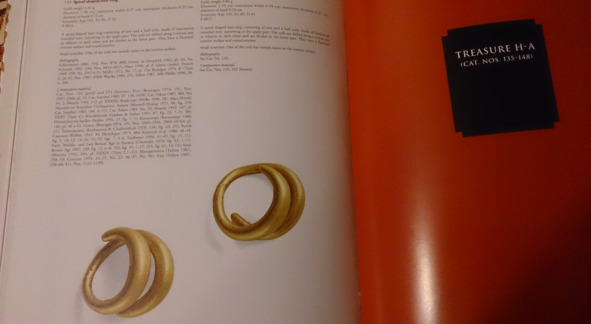
Lobular rings, Schliemann’s treasure, Pushkin Museum of Fine Arts
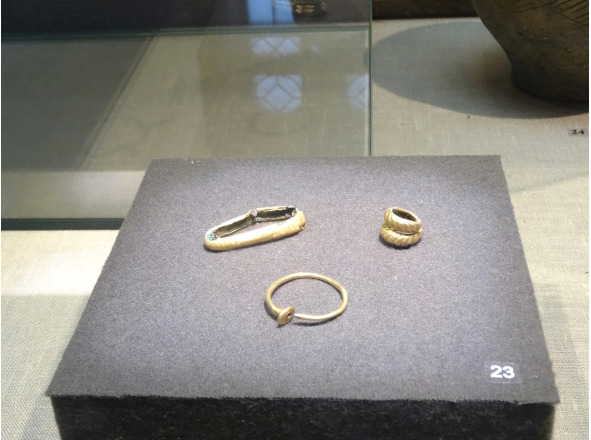
Lobular rings GIM
The oldest boat-shaped bucket found was found in the famous Gorbunovsky peat bog, not far from Omsk, the bucket is made of wood. Belongs to the Abashev culture, dated to the middle of the 20th millennium BC. So the use of ladles in everyday life was a characteristic feature of the Indo-European culture of the Bronze Age from Denmark and Russia, Greece, in Russia until the 20th century.
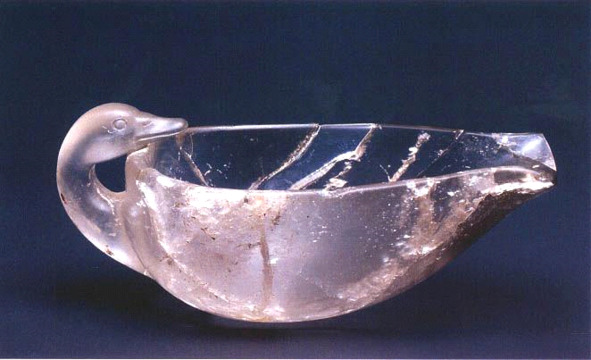
Crystal ladle, Mycenae
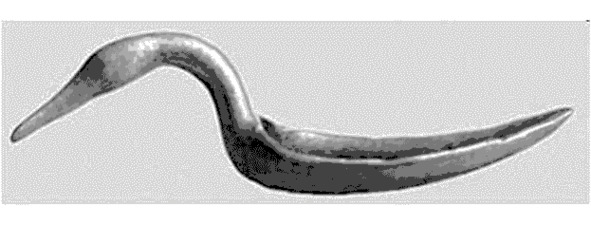
Ladle from the Omsk region, wood
A very interesting find in Greece, a crystal ladle with a handle in the form of a duck’s head was found in Mycenae, dated to the 15th century. BC. The work, of course, is extremely difficult, how could a master make such a fragile thing, because it was not cast and was not blown out of glass? But the shape of this magnificent object copies wood products found in the distant Urals. Wooden buckets are later found in the burials of the Scythians already in the Iron Age, as evidenced by numerous finds. The culture of using ladles in everyday life was preserved in Russia until the 20th century; now these wooden objects are used as decorative dishes. That is, this ritual tableware can also be used as a kind of indicator of Indo-European culture.
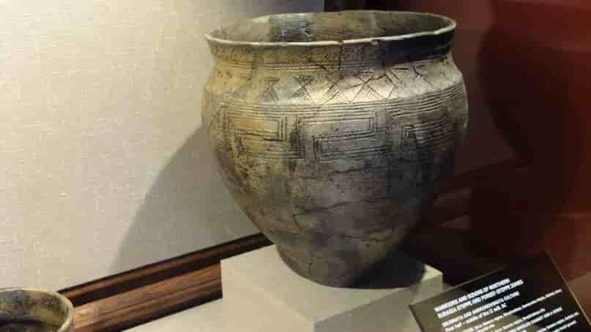
Abashevskaya culture, blackened vessel with a meander of the State Historical Museum, Moscow.
Blackened and milky pottery appears among the artifacts of the Yamnaya and Catacomb culture in the middle of the 3rd thousand BC. The method of making black-glazed ceramics was discovered in the boundless past. Who and when is now impossible to establish. It is known that the Etruscans (VIII – II centuries BC) already had a technology for making black-polished ceramics. In Russia, black-polished household utensils were widespread; the peak of its popularity fell on the period from the 3rd to the 19th centuries. The method is quite simple – the ceramics are smoothed, then the products are fired in a smoking flame without oxygen (staining). Milk is a very appetizing formulation and one of the most popular fire decorating methods. The bottom line is as follows – a sintered shard (which has passed through the roasting) is placed in milk and then baked again at a lower temperature (about 300°C). And this dish has been seen among the finds since the 3rd thousand BC. and to the present time in the basin of the Volga and Don rivers, and the steppes of the Black Sea region, and the Trans-Urals. Similar pottery was discovered by Schliemann and Taylor during archaeological excavations in Troy and Hellas, and similar utensils have been found in Crete and date back to the beginning of the third millennium BC. Bracelets, pins, wands with the image of a volute (double spiral) can also be called iconic. These finds are massive, and open bracelets with volute are one of the signs of these cultures.
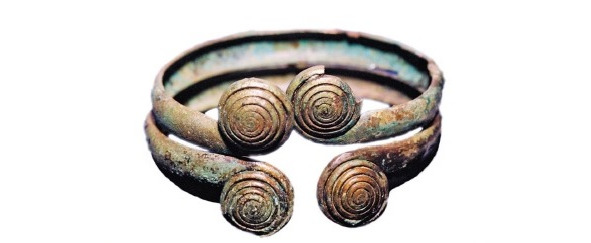
Bronze bracelet from Sintashta

monuments of Koban culture, State Historical Museum
The gigantic rise of the Huns
Huns-Hans, but just real, ethnic Huns. and not members of the union of tribes who adopted the Hunnic culture, was distinguished by extremely high growth. According to the findings of the Tarim mummies belonging to the Andronovo culture, they grew up to 200 cm. The mummies were discovered in 1939. Bergman, and the most impressive finds in China were in the 1980s, where well-preserved remains were found, exhibited in the Urumqi Museum.
All the legends about the giants of Greece speak of the extremely high growth of these heroes, in Germany the Huns (Huns) are called giants, and the Burgundians, part of the Huns, also had gigantic stature according to the letters of the Romans. Savirs-Seversk-northerners of Novgorod-Seversk Land reached a height of 180 cm.
The closest to the Andronovites were the representatives of the European Corded Ware culture and the Sintashta culture, as well as modern Indian populations, according to the study by Keyser C. et al. “Ancient DNA provides new insights into the history of south Siberian Kurgan people.”
The magical power of number seven
The number seven appears to be significant for these northern tribes. There are numerous depictions of seven-pointed stars. Seven tribes of the union of Slavic tribes are known, the Union of seven Slavic tribes (Greek έptά γενεάς – “Seven clans” or “Seven tribes”) is an intertribal union of Slavs in the 7th century on the Balkan Peninsula, which, along with the Bulgars and other Slavs, became the basis of the future states of the First Bulgarian Kingdom and the Bulgarian people. The seven Hungarian tribes are Nyek (Hungarian Nyék), Meguer, Kurt-guarmat, Tarjan, Eno (Yeno) – one of the seven Hungarian tribes, Ker, Kesi. It would seem that there are different tribes, Hephtalites, Hungarians, Slavs. and everywhere the sacred union of the seven tribes. By the way, there is a Septimania region in France, and there were seven kingdoms in Britain – Mercia, Northumbria, East Anglia, Essex, Sussex, Sussex, and Kent. Seven wonders of the World that Hellas spoke about,



